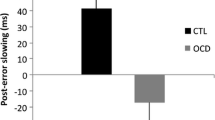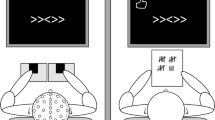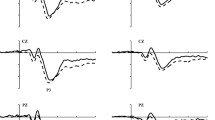Abstract
Overactive performance monitoring has been consistently reported in obsessive–compulsive disorder (OCD). OCD is a clinically heterogeneous disorder and is characterized by several symptom dimensions that may have partially distinct neural correlates. We examined whether performance-monitoring alterations are related to symptom severity and symptom dimensions. Electrocortical correlates of performance monitoring were assessed in 72 OCD patients and 72 matched healthy comparison participants during a flanker task. Amplitudes of the error- and correct-related negativity as well as delta and theta power were used to quantify performance-monitoring activity, and a composite measure was derived using factor analysis. Symptom dimension scores were obtained from the Yale-Brown Obsessive Compulsive Scale symptom checklist. OCD patients showed increased electrocortical responses associated with correct and erroneous responses compared to healthy comparison participants. In patients, no correlations were obtained between performance monitoring and global symptom severity as well as lifetime symptom dimension scores. Only a statistical trend was found that higher symmetry/hoarding scores were associated with reduced performance-monitoring activity. For present symptom dimensions scores, an association with rituals/superstitious symptoms was obtained such that higher scores were associated with greater performance-monitoring activity. However, for both dimensions, subjects with low scores or high scores on each dimension were characterized by overactive performance monitoring compared to healthy controls. Overactive brain processes during performance monitoring are a neural correlate of OCD that is independent of global symptom severity and can be observed for all symptom dimensions. This supports the notion of overactive performance monitoring being a candidate endophenotype for OCD.


Similar content being viewed by others
References
Aouizerate B, Guehl D, Cuny E, Rougier A, Bioulac B, Tignol J, Burbaud P (2004) Pathophysiology of obsessive–compulsive disorder: a necessary link between phenomenology, neuropsychology, imagery and physiology. Prog Neurobiol 72(3):195–221. doi:10.1016/j.pneurobio.2004.02.004
Saxena S, Brody AL, Schwartz JM, Baxter LR (1998) Neuroimaging and frontal-subcortical circuitry in obsessive–compulsive disorder. Br J Psychiatry 173(Suppl 35):26–37
Gilbert AR, Mataix-Cols D, Almeida JR, Lawrence N, Nutche J, Diwadkar V, Keshavan MS, Phillips ML (2008) Brain structure and symptom dimension relationships in obsessive–compulsive disorder: a voxel-based morphometry study. J Affect Disord 109(1–2):117–126. doi:10.1016/j.jad.2007.12.223
Alvarenga PG, do Rosario MC, Batistuzzo MC, Diniz JB, Shavitt RG, Duran FL, Dougherty DD, Bressan RA, Miguel EC, Hoexter MQ (2012) Obsessive–compulsive symptom dimensions correlate to specific gray matter volumes in treatment-naive patients. J Psychiatr Res 46(12):1635–1642. doi:10.1016/j.jpsychires.2012.09.002
Mataix-Cols D, Wooderson S, Lawrence N, Brammer MJ, Speckens A, Phillips ML (2004) Distinct neural correlates of washing, checking, and hoarding symptom dimensions in obsessive–compulsive disorder. Arch Gen Psychiatry 61(6):564–576. doi:10.1001/archpsyc.61.6.564
van den Heuvel OA, Remijnse PL, Mataix-Cols D, Vrenken H, Groenewegen HJ, Uylings HB, van Balkom AJ, Veltman DJ (2009) The major symptom dimensions of obsessive–compulsive disorder are mediated by partially distinct neural systems. Brain 132(4):853–868. doi:10.1093/brain/awn267
Iervolino AC, Rijsdijk FV, Cherkas L, Fullana MA, Mataix-Cols D (2011) A multivariate twin study of obsessive–compulsive symptom dimensions. Arch Gen Psychiatry 68(6):637–644. doi:10.1001/archgenpsychiatry.2011.54
Katerberg H, Delucchi KL, Stewart SE, Lochner C, Denys DA, Stack DE, Andresen JM, Grant JE, Kim SW, Williams KA, den Boer JA, van Balkom AJ, Smit JH, van Oppen P, Polman A, Jenike MA, Stein DJ, Mathews CA, Cath DC (2010) Symptom dimensions in OCD: item-level factor analysis and heritability estimates. Behav Genet 40(4):505–517. doi:10.1007/s10519-010-9339-z
Hasler G, LaSalle-Ricci VH, Ronquillo JG, Crawley SA, Cochran LW, Kazuba D, Greenberg BD, Murphy DL (2005) Obsessive–compulsive disorder symptom dimensions show specific relationships to psychiatric comorbidity. Psychiatry Res 135(2):121–132. doi:10.1016/j.psychres.2005.03.003
Mataix-Cols D, Rauch SL, Manzo PA, Jenike MA, Baer L (1999) Use of factor-analyzed symptom dimensions to predict outcome with serotonin reuptake inhibitors and placebo in the treatment of obsessive–compulsive disorder. Am J Psychiatry 156(9):1409–1416. doi:10.1176/appi.ajp.162.2.228
Goodman WK, Price LH, Rasmussen SA, Mazure C, Fleischmann RL, Hill CL, Heninger GR, Charney DS (1989) The Yale-Brown Obsessive Compulsive Scale. I. Development, use, and reliability. Arch Gen Psychiatry 46(11):1006–1011. doi:10.1001/archpsyc.1989.01810110048007
Mataix-Cols D, Rosario-Campos MC, Leckman JF (2005) A multidimensional model of obsessive–compulsive disorder. Am J Psychiatry 162(2):228–238. doi:10.1176/appi.ajp.162.2.228
Endrass T, Klawohn J, Schuster F, Kathmann N (2008) Overactive performance monitoring in obsessive–compulsive disorder: ERP evidence from correct and erroneous reactions. Neuropsychologia 46(7):1877–1887. doi:10.1016/j.neuropsychologia.2007.12.001
Endrass T, Schuermann B, Kaufmann C, Spielberg R, Kniesche R, Kathmann N (2010) Performance monitoring and error significance in patients with obsessive–compulsive disorder. Biol Psychol 84(2):257–263. doi:10.1016/j.biopsycho.2010.02.002
Fitzgerald KD, Welsh RC, Gehring WJ, Abelson JL, Himle JA, Liberzon I, Taylor SF (2005) Error-related hyperactivity of the anterior cingulate cortex in obsessive–compulsive disorder. Biol Psychiatry 57(3):287–294. doi:10.1016/j.biopsych.2004.10.038
Gehring WJ, Himle J, Nisenson LG (2000) Action-monitoring dysfunction in obsessive–compulsive disorder. Psychol Sci 11(1):1–6. doi:10.1111/1467-9280.00206
Hajcak G, Franklin ME, Foa EB, Simons RF (2008) Increased error-related brain activity in pediatric obsessive–compulsive disorder before and after treatment. Am J Psychiatry 165(1):116–123. doi:10.1176/appi.ajp.2007.07010143
Huyser C, Veltman DJ, Wolters LH, de Haan E, Boer F (2011) Developmental aspects of error and high-conflict-related brain activity in pediatric obsessive–compulsive disorder: a fMRI study with a Flanker task before and after CBT. J Child Psychol Psychiatry 52(12):1251–1260. doi:10.1111/j.1469-7610.2011.02439.x
Johannes S, Wieringa BM, Nager W, Rada D, Dengler R, Emrich HM, Münte TF, Dietrich DE (2001) Discrepant target detection and action monitoring in obsessive–compulsive disorder. Psychiatry Res 108(2):101–110. doi:10.1016/S0925-4927(01)00117-2
Maltby N, Tolin DF, Worhunsky P, O’Keefe TM, Kiehl KA (2005) Dysfunctional action monitoring hyperactivates frontal–striatal circuits in obsessive–compulsive disorder: an event-related fMRI study. NeuroImage 24(2):495–503. doi:10.1016/j.neuroimage.2004.08.041
Mathews CA, Perez VB, Delucchi KL, Mathalon DH (2012) Error-related negativity in individuals with obsessive–compulsive symptoms: toward an understanding of hoarding behaviors. Biol Psychol 89(2):487–494. doi:10.1016/j.biopsycho.2011.12.018
Riesel A, Endrass T, Kaufmann C, Kathmann N (2011) Overactive error-related brain activity as a candidate endophenotype for obsessive–compulsive disorder: evidence from unaffected first-degree relatives. Am J Psychiatry 168(3):317–324. doi:10.1176/appi.ajp.2010.10030416
Ruchsow M, Gron G, Reuter K, Spitzer M, Hermle L, Kiefer M (2005) Error-related brain activity in patients with obsessive–compulsive disorder and in healthy controls. J Psychophysiol 19(4):298. doi:10.1027/0269-8803.19.4.298
Stern ER, Liu Y, Gehring WJ, Lister JJ, Yin G, Zhang J, Fitzgerald KD, Himle JA, Abelson JL, Taylor SF (2010) Chronic medication does not affect hyperactive error responses in obsessive–compulsive disorder. Psychophysiology 47(5):913–920. doi:10.1111/j.1469-8986.2010.00988.x
Ursu S, Stenger VA, Shear MK, Jones MR, Carter CS (2003) Overactive action monitoring in obsessive–compulsive disorder: evidence from functional magnetic resonance imaging. Psychol Sci 14(4):347–353. doi:10.1111/1467-9280.24411
Carrasco M, Harbin SM, Nienhuis JK, Fitzgerald KD, Gehring WJ, Hanna GL (2013) Increased error-related brain activity in youth with obsessive–compulsive disorder and unaffected siblings. Depress Anxiety 30(1):39–46. doi:10.1002/da.22035
Gehring WJ, Goss B, Coles MGH, Meyer DE, Donchin E (1993) A neural system for error-detection and compensation. Psychol Sci 4(6):385–390. doi:10.1111/j.1467-9280.1993.tb00586.x
Falkenstein M, Hohnsbein J, Hoormann J, Blanke L (1991) Effects of crossmodal divided attention on late ERP components. II. Error processing in choice reaction tasks. Electroencephalogr Clin Neurophysiol 78(6):447–455. doi:10.1016/0013-4694(91)90062-9
Ford JM (1999) Schizophrenia: the broken P300 and beyond. Psychophysiology 36(6):667–682. doi:10.1111/1469-8986.3660667
Luu P, Tucker DM, Makeig S (2004) Frontal midline theta and the error-related negativity: neurophysiological mechanisms of action regulation. Clin Neurophysiol 115(8):1821–1835. doi:10.1016/j.clinph.2004.03.031
Cavanagh JF, Cohen MX, Allen JJB (2009) Prelude to and resolution of an error: EEG phase synchrony reveals cognitive control dynamics during action monitoring. J Neurosci 29(1):98–105. doi:10.1523/Jneurosci.4137-08.2009
Cavanagh JF, Zambrano-Vazquez L, Allen JJ (2012) Theta lingua franca: a common mid-frontal substrate for action monitoring processes. Psychophysiology 49(2):220–238. doi:10.1111/j.1469-8986.2011.01293.x
Trujillo LT, Allen JJ (2007) Theta EEG dynamics of the error-related negativity. Clin Neurophysiol 118(3):645–668. doi:10.1016/j.clinph.2006.11.009
Yordanova J, Falkenstein M, Hohnsbein J, Kolev V (2004) Parallel systems of error processing in the brain. NeuroImage 22(2):590–602. doi:10.1016/j.neuroimage.2004.01.040
Debener S, Ullsperger M, Siegel M, Fiehler K, von Cramon DY, Engel AK (2005) Trial-by-trial coupling of concurrent electroencephalogram and functional magnetic resonance imaging identifies the dynamics of performance monitoring. J Neurosci 25(50):11730–11737. doi:10.1523/JNEUROSCI.3286-05.2005
Ridderinkhof KR, Ullsperger M, Crone EA, Nieuwenhuis S (2004) The role of the medial frontal cortex in cognitive control. Science 306(5695):443–447. doi:10.1126/science.1100301
Tsujimoto T, Shimazu H, Isomura Y (2006) Direct recording of theta oscillations in primate prefrontal and anterior cingulate cortices. J Neurophysiol 95(5):2987–3000. doi:10.1152/jn.00730.2005
Anokhin A, Golosheykin S, Heath A (2008) Heritability of frontal brain function related to action monitoring. Psychophysiology 45(4):524–534. doi:10.1111/j.1469-8986.2008.00664.x
Gottesman II, Gould TD (2003) The endophenotype concept in psychiatry: etymology and strategic intentions. Am J Psychiatry 160(4):636–645. doi:10.1176/appi.ajp.160.4.636
Steer RA, Ball R, Ranieri WF, Beck AT (1997) Further evidence for the construct validity of the Beck depression Inventory-II with psychiatric outpatients. Psychol Rep 80(2):443–446. doi:10.2466/pr0.1997.80.2.443
Foa EB, Huppert JD, Leiberg S, Langner R, Kichic R, Hajcak G, Salkovskis PM (2002) The Obsessive–Compulsive Inventory: development and validation of a short version. Psychol Assess 14(4):485–496. doi:10.1037/1040-3590.14.4.485
Schmidt KH, Metzler P (1992) WST. Wortschatztest. Beltz Test GmbH, Göttingen
Montgomery SA, Asberg M (1979) A new depression scale designed to be sensitive to change. Br J Psychiatry 134:382–389. doi:10.1192/bjp.134.4.382
Kopp B, Rist F, Mattler U (1996) N200 in the flanker task as a neurobehavioral tool for investigating executive control. Psychophysiology 33(3):282–294. doi:10.1111/j.1469-8986.1996.tb00425.x
Endrass T, Franke C, Kathmann N (2005) Error awareness in a saccade countermanding task. J Psychophysiol 19(4):275–280. doi:10.1027/0269-8803.19.4.275
Endrass T, Reuter B, Kathmann N (2007) ERP correlates of conscious error recognition: aware and unaware errors in an antisaccade task. Eur J Neurosci 26(6):1714–1720. doi:10.1111/j.1460-9568.2007.05785.x
Endrass T, Klawohn J, Preuss J, Kathmann N (2012) Temporospatial dissociation of Pe subcomponents for perceived and unperceived errors. Front Hum Neurosci 6:178. doi:10.3389/fnhum.2012.00178
Hajcak G, Simons RF (2002) Error-related brain activity in obsessive–compulsive undergraduates. Psychiatry Res 110(1):63–72. doi:10.1016/S0165-1781(02)00034-3
Endrass T, Klawohn J, Gruetzmann R, Ischebeck M, Kathmann N (2012) Response-related negativities following correct and incorrect responses: evidence from a temporospatial principal component analysis. Psychophysiology 49(6):733–743. doi:10.1111/j.1469-8986.2012.01365.x
Pitman RK (1987) A cybernetic model of obsessive–compulsive psychopathology. Compr Psychiatry 28(4):334–343. doi:10.1016/0010-440X(87)90070-8
Bocci L, Gordon PK (2007) Does magical thinking produce neutralising behaviour? An experimental investigation. Behav Res Ther 45(8):1823–1833. doi:10.1016/j.brat.2007.02.003
West B, Willner P (2011) Magical thinking in obsessive–compulsive disorder and generalized anxiety disorder. Behav Cogn Psychother 39(4):399–411. doi:10.1017/S1352465810000883
Botvinick MM, Braver TS, Barch DM, Carter CS, Cohen JD (2001) Conflict monitoring and cognitive control. Psychol Rev 108(3):624–652. doi:10.1037//0033-295x.108.3.624
Mataix-Cols D, Frost RO, Pertusa A, Clark LA, Saxena S, Leckman JF, Stein DJ, Matsunaga H, Wilhelm S (2010) Hoarding disorder: a new diagnosis for DSM-V? Depress Anxiety 27(6):556–572. doi:10.1002/da.20693
Steketee G, Frost R (2003) Compulsive hoarding: current status of the research. Clin Psychol Rev 23(7):905–927. doi:10.1016/j.cpr.2003.08.002
Chiu PH, Deldin PJ (2007) Neural evidence for enhanced error detection in major depressive disorder. Am J Psychiatry 164(4):608–616. doi:10.1176/appi.ajp.164.4.608
Weinberg A, Olvet DM, Hajcak G (2010) Increased error-related brain activity in generalized anxiety disorder. Biol Psychol 85:472–480. doi:10.1016/j.biopsycho.2010.09.011
Weinberg A, Riesel A, Hajcak G (2012) Integrating multiple perspectives on error-related brain activity: ERN as a neurobehavioral trait. Motiv Emot 36:84–100. doi:10.1007/s11031-011-9269-y
Xiao Z, Wang J, Zhang M, Li H, Tang Y, Wang Y, Fan Q, Fromson JA (2011) Error-related negativity abnormalities in generalized anxiety disorder and obsessive–compulsive disorder. Prog Neuropsychopharmacol Biol Psychiatry 35(1):265–272. doi:10.1016/j.pnpbp.2010.11.022
Weinberg A, Klein DN, Hajcak G (2012) Increased error-related brain activity distinguishes generalized anxiety disorder with and without comorbid major depressive disorder. J Abnorm Psychol 121(4):885–896. doi:10.1037/a0028270
Schrijvers D, de Bruijn ERA, Maas Y, De Grave C, Sabbe BGC, Hulstijn W (2008) Action monitoring in major depressive disorder with psychomotor retardation. Cortex 44(5):569–579
Schrijvers D, De Bruijn ER, Maas YJ, Vancoillie P, Hulstijn W, Sabbe BGC (2009) Action monitoring and depressive symptom reduction in major depressive disorder. Int J Psychophysiol 71(3):218–224. doi:10.1016/j.ijpsycho.2008.09.005
Grundler TO, Cavanagh JF, Figueroa CM, Frank MJ, Allen JJ (2009) Task-related dissociation in ERN amplitude as a function of obsessive–compulsive symptoms. Neuropsychologia 47(8–9):1978–1987. doi:10.1016/j.neuropsychologia.2009.03.010
Santesso DL, Segalowitz SJ, Schmidt LA (2006) Error-related electrocortical responses are enhanced in children with obsessive–compulsive behaviors. Dev Neuropsychol 29(3):431–445. doi:10.1207/s15326942dn2903_3
Acknowledgments
The authors thank Thomas Pinkpank and Rainer Kniesche for their technical support and Ulrike Bunzenthal, Lea Auerbach, Sandy Kias, Anika Momberg, and Carolin Stoppe for their help in data collection. Anja Riesel received funding from a predoctoral fellowship (Else-Neumann-Scholarship).
Conflict of interest
On behalf of all authors, the corresponding author states that there is no conflict of interest.
Author information
Authors and Affiliations
Corresponding author
Rights and permissions
About this article
Cite this article
Riesel, A., Kathmann, N. & Endrass, T. Overactive performance monitoring in obsessive–compulsive disorder is independent of symptom expression. Eur Arch Psychiatry Clin Neurosci 264, 707–717 (2014). https://doi.org/10.1007/s00406-014-0499-3
Received:
Accepted:
Published:
Issue Date:
DOI: https://doi.org/10.1007/s00406-014-0499-3




